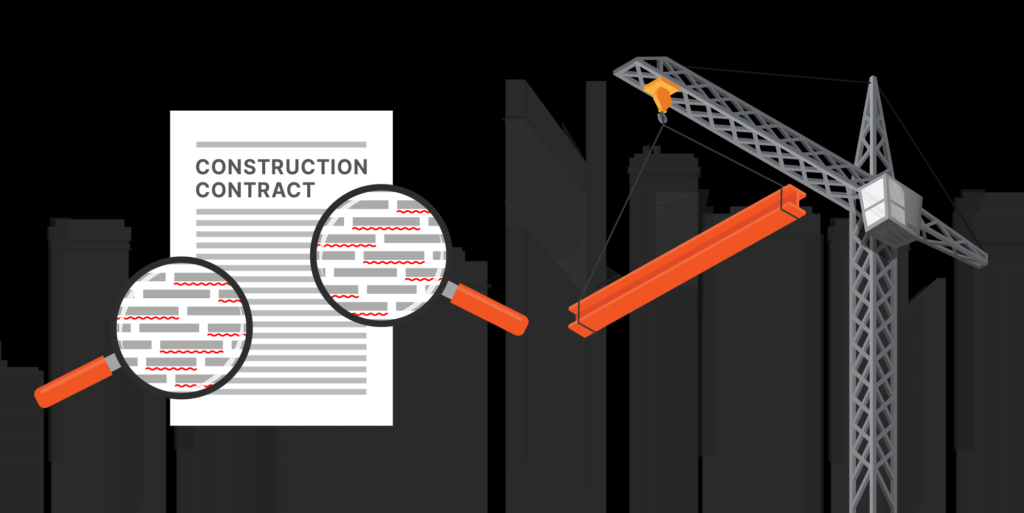— 5 min read
Construction Contract Administration: Roles & Responsibilities


Last Updated Sep 6, 2024

Janine Trinidad
Staff Trainer and Program Manager
25 articles
Janine Trinidad is a Construction Educational professional for Procore Technologies. In previous roles, Janine managed all phases of construction on hotel, mixed-use, and institutional projects in the San Francisco Bay area. She was responsible for negotiating contract budgets and change orders, managing RFIs and submittals, and overseeing quality control, among other duties. She is also a certified transformational coach with a focus on women-centered and trauma-informed methods. She is passionate about transforming the construction industry to be a healthier, more successful and welcoming place to work and believes technology and education are allies in doing so.

David Giali
Content Manager, NAMER
11 articles
David is a Content Manager for North America at Procore Technologies. He is an experienced writer in the software industry with close to 1000 published articles. Before writing, he worked in for a specialty contractor as an estimator and finish contractor. David spends his time outdoors with his wife and dog, experimenting with film photography, and writing music.

Justin Vogel
Senior Solutions Engineer, Owners
Justin is a Senior Strategic Product Consultant for Procore. Justin has an extensive background in real estate development, construction engineering, and project management professional entrusted with high profile structures, and is involved in over $3.5 billion worth of construction representing developers, CEO's, GC's, equity partners, consultants, and attorneys in unique and complex pursuits.
Last Updated Sep 6, 2024

Construction contracts, especially for large projects, can be extremely detailed with many key documents often compiling thousands of pages. Because of this, larger firms have a dedicated role to keep track of the contract.
Contract administrators serve as the dedicated point-person among stakeholders, meticulously converting non-legal documents into legally binding contracts without distorting the original intent. While they are seldom the sole originators of contract language, much of their expertise lies in organizing the many elements into cohesive drafts for executive and legal endorsement.
This article aims to demystify contract administration, uncovering the contract administrator’s role in the construction industry.
Table of contents
Contract Admin vs. Construction Admin
There is some confusion within the construction industry between the terms “contract administrator” and “construction administrator.” This could possibly be due to a generational change of meaning, misuse of the terms or a general misunderstanding of what each role does.
Contract Administration: Contract administration is centered on overseeing contractual agreements and ensuring that all parties involved adhere to these agreements.
Construction Administration: In contrast, construction administration is typically the responsibility of architects, who ensure that the construction work aligns with the established drawings and specifications.
Additionally, construction administration involves the management of on-site operational execution, verifying that the build complies with the design and design intent.
What does a Contract Administrator do?
Generally speaking, the contract administrator plays an intermediary role amongst the many parties involved in a construction agreement, safeguarding contractual compliance and fostering relationships. This individual is tasked with transforming non-binding documents into full-fledged legal contracts, ensuring the original content remains unaltered. While not always charged with the initial writing of a contract, the administrator is instrumental in assembling its various components.
The responsibilities of a contract administrator will vary depending on whether the contract administrator is working for an owner or a general contractor. Highlighted below are a few of the differences between the two:
| Owner | General Contractor |
|---|---|
| A contract administrator working for an owner will spend most of their time doing all of the prerequisites a contract goes through before it’s in the hands of the owner and their legal counsel. Contract administrators will contribute to the preparation of the contract's initial draft, which will later receive final approval from an executive legal counsel. Following the execution of the contract, the administrator continues to play an active role, particularly in managing change orders and integrating them as official amendments to the legal agreement. | A general contractor’s contract administrator is similar to that of an owner’s, but differs in the sense that there are more contracts to administer for one project – due to the fact that general contractors issue individual subcontracts for the many specialty contractors hired onto a project. Contract Administrators who work for GCs hold the responsibility of putting together each contract for the specialty contractors, approving that each document adheres to the prime contract, and getting each contract signed by the respective party. Unlike contract admins for owners, admins for a GC will continue working alongside project managers following the execution of the contract, playing an active role in managing change orders and integrating them as official amendments to the legal agreement. |
Define and Maintain Relationships
One of the earliest tasks to ensure successful Contract Administration should be the creation of a contact list for as many people and entities associated with the project as possible. On the owners side, this will include the architects and GCs.
When working for a GC, this includes the project’s owner, manager, architect, superintendent, field engineers, subcontractors, vendors and materials suppliers. Defining the legal entities and persons who are responsible for signing parties to the contract is the role of the Contract Administrator, as these could be different from the point of contact for operations and logistics.
Understand Documentation
Another aspect of the role is incorporating non-binding documents into contract documents, which requires a high-level comprehension of their purpose in construction and the authoring source of those documents. Additionally, understanding the way in which the contract defines scope, schedule and cost allows contract administrators to establish clear contractual obligations and performance expectations, in hopes that all parties are protected from future litigation.
That being said, contract administrators do not write all of the contractual language. Though contract administrators are expected to have a better understanding of the project scope, schedule, and logistics, they often collaborate with consultants — such as legal counsel, who would be more experienced in legal language and contract law — or use an industry-recognized template.
Handle Changes
Changes in construction projects are inevitable. Omissions or oversights in the contract documents may be discovered only during the construction process, or exigent circumstances can come to bear, making schedule adherence impossible. Perhaps the owner wants to upgrade or alter the project somehow. No matter the reason, properly applying for a project change is part of contract administration and is done via change orders.
Change orders are written submissions for adjustments to a project’s scope or timeline. Upon approval they become incorporated into the prime contract, creating new (and legally binding) rights and obligations between the owner and GC.
Change orders can adjust the project’s schedule, scope or value either up or down: For example, an owner may abandon the previously intended tile floors of a structure in favor of (typically cheaper) carpeting. Change orders can be small, but also large — such as adding an entirely new subdivision onto a planned community.
No matter the change requested, the cardinal rule for those administering the contract is to never authorize work that deviates from the contract documents without an approved change order. Doing so creates the risk of double work, unpaid work, project disputes and breach of contract.
Stay updated on what’s happening in construction.
Subscribe to Blueprint, Procore’s free construction newsletter, to get content from industry experts delivered straight to your inbox.

The Future of Contract Administration
Successful contract administration is all about synthesizing and managing the (often thousands) of documents associated with a project. This task could have been near-overwhelming in the days of pencils, spreadsheets, logbooks and paper forms.
Fortunately, construction has gone digital in the last few decades. Now, platforms exist on which all functions of contract administration can be accomplished seamlessly and at scale. Admins can use digital platforms to track and remind project participants of upcoming actionable dates, when reviews, renewals, reports or special filings will be required, in order to keep a project on track for the scheduled completion.
Even more exciting are the possibilities for artificial intelligence to revolutionize the contract administration process, taking away the grueling tasks of organizing the thousands of compiled documents or searching through them for project forensics.
Was this article helpful?
Thank you for your submission.
92%
8%
You voted that this article was . Was this a mistake? If so, change your vote
Scroll less, learn more about construction.
Subscribe to The Blueprint, Procore’s construction newsletter, to get content from industry experts delivered straight to your inbox.
By clicking this button, you agree to our Privacy Notice and Terms of Service.
Thank you!
You’re signed up to receive The Blueprint newsletter from Procore. You can unsubscribe at any time.
Categories:
Written by

Janine Trinidad
Staff Trainer and Program Manager | Procore Technologies
25 articles
Janine Trinidad is a Construction Educational professional for Procore Technologies. In previous roles, Janine managed all phases of construction on hotel, mixed-use, and institutional projects in the San Francisco Bay area. She was responsible for negotiating contract budgets and change orders, managing RFIs and submittals, and overseeing quality control, among other duties. She is also a certified transformational coach with a focus on women-centered and trauma-informed methods. She is passionate about transforming the construction industry to be a healthier, more successful and welcoming place to work and believes technology and education are allies in doing so.
View profile
David Giali
Content Manager, NAMER | Procore Technologies
11 articles
David is a Content Manager for North America at Procore Technologies. He is an experienced writer in the software industry with close to 1000 published articles. Before writing, he worked in for a specialty contractor as an estimator and finish contractor. David spends his time outdoors with his wife and dog, experimenting with film photography, and writing music.
View profileReviewed by

Justin Vogel
Senior Solutions Engineer, Owners | Procore
Justin is a Senior Strategic Product Consultant for Procore. Justin has an extensive background in real estate development, construction engineering, and project management professional entrusted with high profile structures, and is involved in over $3.5 billion worth of construction representing developers, CEO's, GC's, equity partners, consultants, and attorneys in unique and complex pursuits.
View profileExplore more helpful resources

Using Standard Operating Procedures for Better Contract Management
Every construction project is different, meaning that GCs have to be continually agile and strategic about applying their experience. Major categories change from project to project, from the owner to...

Understanding Supplementary Conditions on Construction Contracts
No two construction projects are exactly alike — and the same goes for construction contracts. Even when using a standard contract form, owners and contractors sometimes use supplementary conditions to...

A Straightforward Guide to Construction Contract Review
Construction contracts are like the glue for the project team. They’re the ties that bind the working relationships and goals for the project, containing information about responsibilities, liabilities and processes...

Escalation Clauses in Construction Contracts: When and How They Apply
In construction contracts, an escalation clause allows for the escalation of a certain price for labor or materials to be used in a construction project. This type of clause is most...
Free Tools
Calculators
Use our calculators to estimate the cost of construction materials for your next project.
Templates
Find a template to help you with your construction project tasks.
Material Price Tracker
Get the latest U.S. retail prices and view historical trends for common building materials.
Glossary
Explore key terms and phrases used in the industry.
